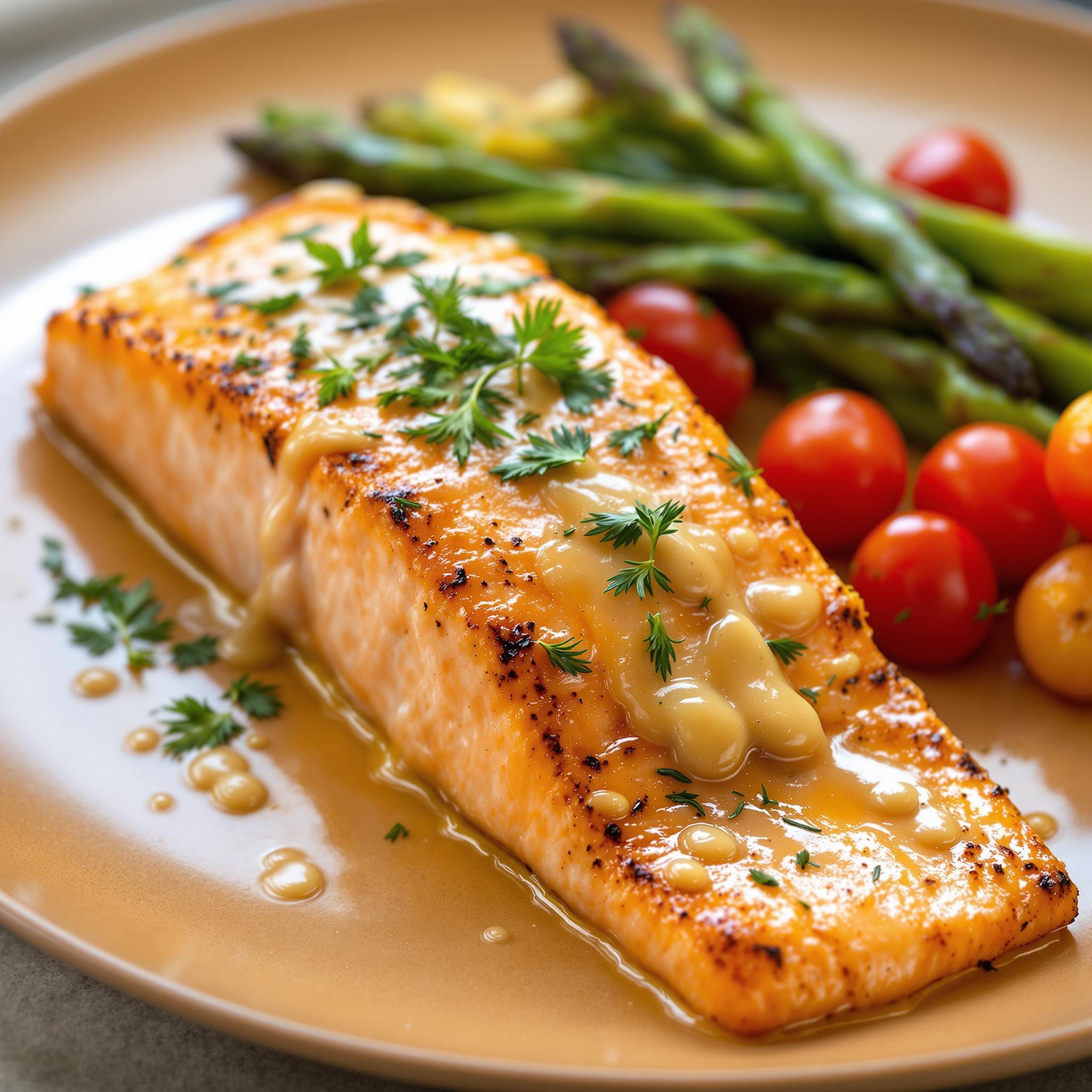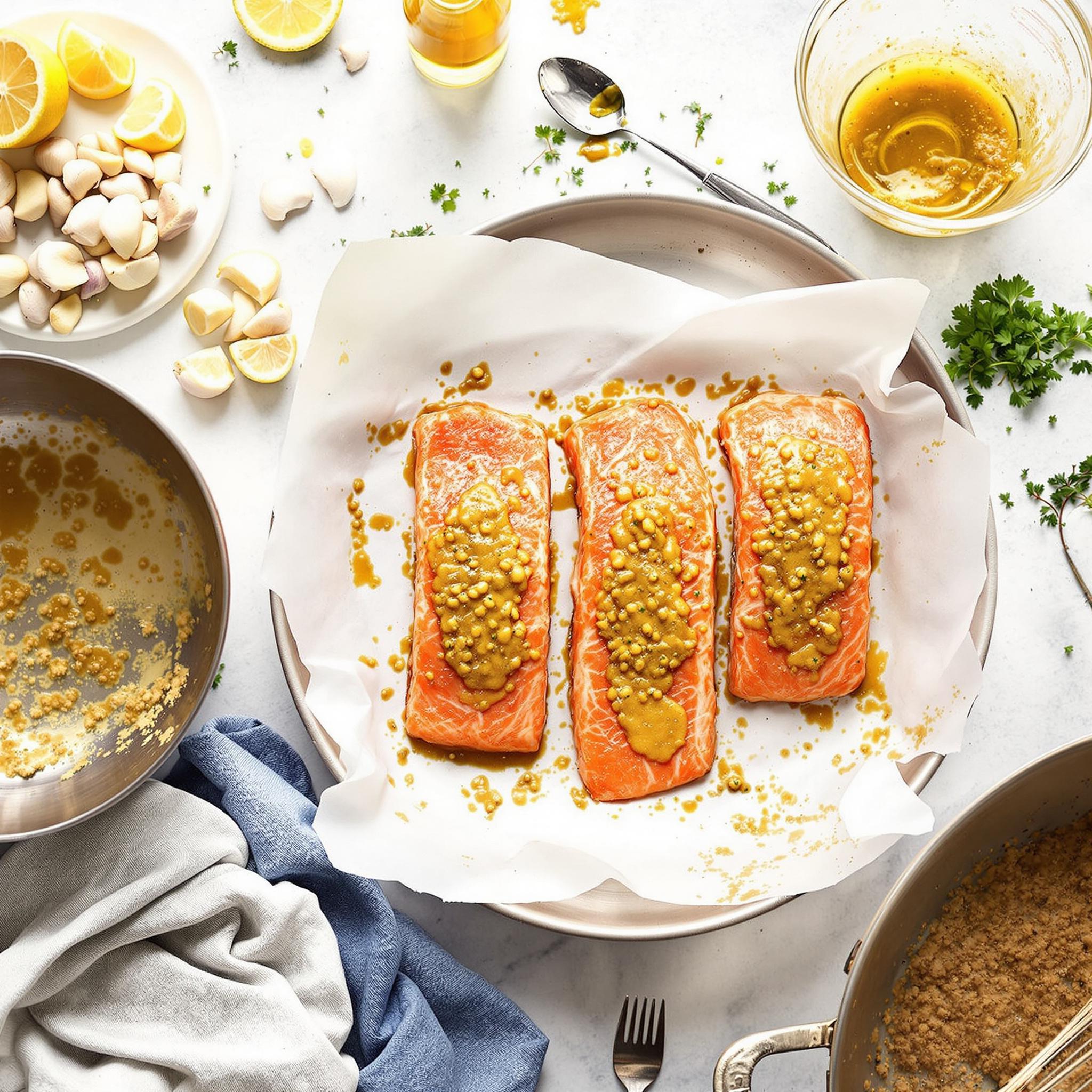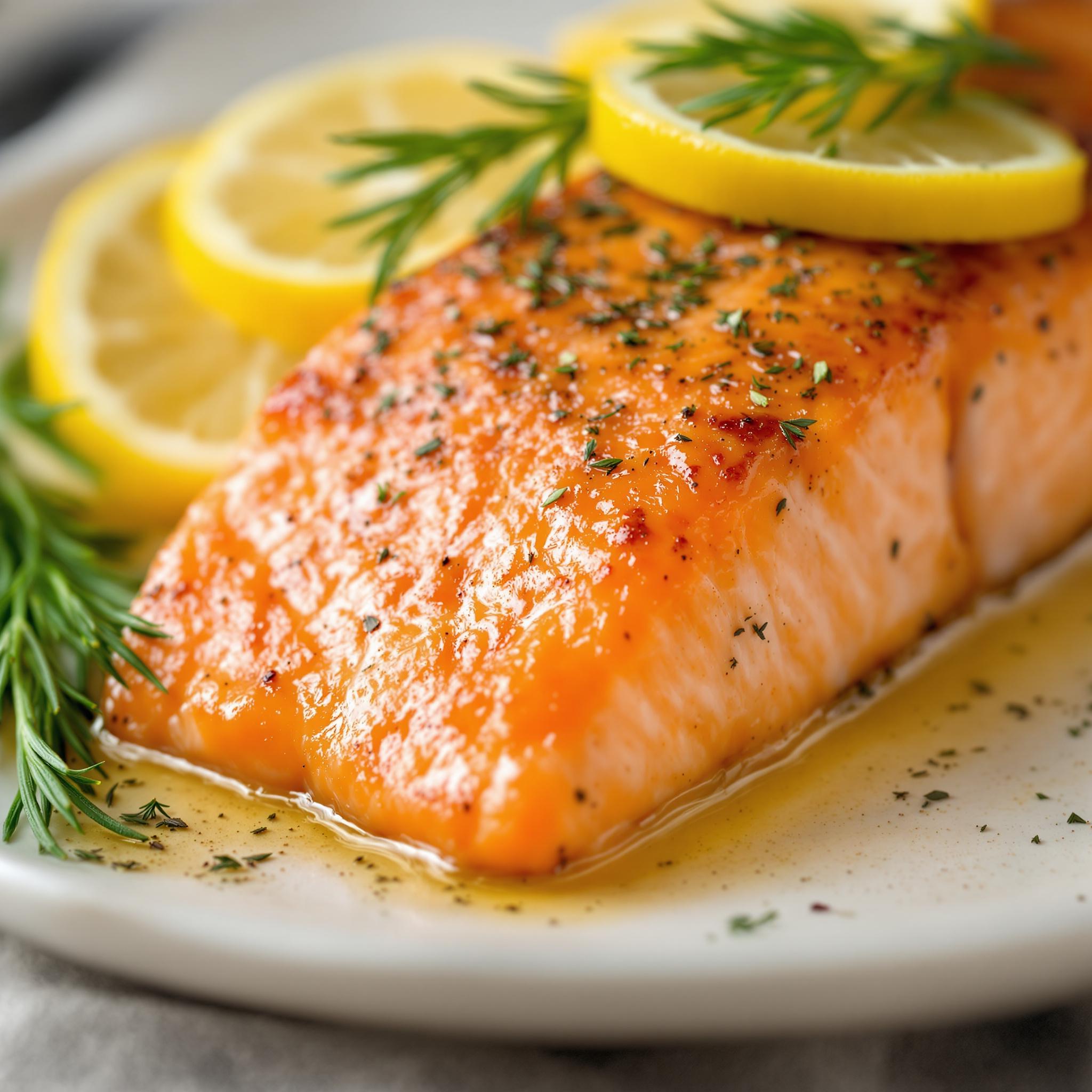
Introduction to Baked Dijon Salmon
There’s something magical about the combination of tender salmon, tangy Dijon mustard, and a touch of sweetness that makes Baked Dijon Salmon an absolute crowd-pleaser. Whether you’re cooking for family or hosting friends, this dish is guaranteed to impress. I first made this recipe on a chilly Sunday evening when I wanted something quick yet elegant. The aroma of garlic and herbs wafting through my kitchen was enough to make everyone gather around the table before it was even ready! Trust me, once you try this baked salmon recipe, it’ll become your go-to dish.
The Origin of Baked Dijon Salmon
Baked Dijon Salmon is a modern twist on classic French-inspired cuisine. Dijon mustard, originating from the Burgundy region of France, has been used for centuries as a versatile condiment. Traditionally paired with meats like beef or pork, its sharp flavor also complements fish beautifully. Over time, home cooks began experimenting with baking techniques to create dishes like this one—a simple yet sophisticated meal that combines global flavors with minimal effort. It’s perfect for busy weeknights but fancy enough for special occasions too!
Why You’ll Love This Baked Dijon Salmon Recipe
This recipe shines because it’s easy, healthy, and packed with flavor. The creamy texture of the mustard glaze contrasts beautifully with the flaky salmon, while hints of lemon and herbs add brightness. Plus, it takes less than 30 minutes to prepare—perfect for those who want delicious results without spending hours in the kitchen. Whether you’re new to cooking salmon or looking for a fresh take on your favorite fish, this Dijon salmon bake will win you over.
Perfect Occasions to Prepare Baked Dijon Salmon
This dish works wonders for any occasion. Serve it at dinner parties to wow guests with its gourmet flair, or enjoy it during a cozy family meal. It’s also ideal for date nights, holiday gatherings, or even meal prep for the week ahead. With its balance of elegance and simplicity, baked salmon with Dijon mustard fits seamlessly into both casual and formal settings.
Ingredients for Baked Dijon Salmon
- 4 salmon fillets (about 6 ounces each)
- 3 tablespoons Dijon mustard
- 2 tablespoons honey
- 1 tablespoon olive oil
- 2 cloves garlic, minced
- Juice of 1 lemon
- Salt and pepper to taste
- Fresh parsley, chopped (for garnish)
Substitution Options
If you’re missing some ingredients, don’t worry! Swap Dijon mustard with whole-grain mustard for a slightly different texture. Maple syrup can replace honey if you prefer a deeper sweetness. For a dairy-free option, use coconut oil instead of olive oil. And if salmon isn’t available, try trout or cod—they pair just as well with the mustard glaze.
Preparation Steps
Step 1: Preheat Your Oven
Begin by preheating your oven to 400°F (200°C). While the oven heats up, line a baking sheet with parchment paper or lightly grease it with nonstick spray. This ensures the Dijon salmon bake doesn’t stick and makes cleanup a breeze. Pro tip: Parchment paper adds a subtle crispness to the edges of the salmon, enhancing its texture.
Step 2: Prepare the Glaze
In a small bowl, whisk together the Dijon mustard, honey, olive oil, minced garlic, and lemon juice. The mixture should have a smooth consistency with a vibrant golden hue. Taste the glaze and adjust the seasoning with salt and pepper according to your preference. This tangy-sweet blend is what gives the baked salmon with Dijon mustard its signature flavor, so don’t skip this step!
Step 3: Coat the Salmon Fillets
Place the salmon fillets skin-side down on the prepared baking sheet. Generously brush the glaze over each piece, ensuring they’re evenly coated. As you work, notice how the mustard mixture clings to the salmon, promising a caramelized finish once baked. If you’re feeling adventurous, sprinkle a pinch of red pepper flakes for a spicy kick.
Step 4: Bake Until Perfectly Flaky
Bake the salmon in the preheated oven for 12–15 minutes, depending on the thickness of the fillets. Keep an eye on them—the salmon is done when it flakes easily with a fork and reaches an internal temperature of 145°F (63°C). The aroma of roasted garlic and citrus will fill your kitchen, making it hard to resist sneaking a bite early!

Chef’s Tip
For an extra layer of flavor, broil the salmon for 1–2 minutes after baking. This creates a beautifully caramelized top layer that enhances the overall taste of your Dijon salmon bake. Just keep a close watch to prevent burning!
Time Required
- Prep Time: 10 minutes
- Cooking Time: 15 minutes
- Total Time: 25 minutes
Nutritional Information
Per serving (1 fillet): Calories: 280 | Protein: 30g | Fat: 15g | Carbohydrates: 8g | Fiber: 0g | Sugar: 6g
Extra Information
Did you know that salmon is one of the richest sources of omega-3 fatty acids? These essential fats support heart health and brain function, making this baked salmon with Dijon mustard not only tasty but also incredibly nutritious.
Necessary Tools
- Baking sheet
- Parchment paper or nonstick spray
- Small mixing bowl
- Whisk
- Measuring spoons
- Brush for glazing
Storage Instructions
To store leftover Baked Dijon Salmon, let it cool completely before transferring it to an airtight container. Refrigerate for up to 3 days. Reheat gently in the microwave or oven to preserve the fish’s moisture.
If freezing, wrap individual portions tightly in plastic wrap and place them in a freezer-safe bag. They’ll stay good for up to 2 months. Thaw overnight in the fridge before reheating.
Avoid storing the salmon with other strong-smelling foods, as it may absorb odors. Always reheat thoroughly to ensure food safety.
Tips and Tricks
- Pat the salmon dry with paper towels before glazing—it helps achieve a better sear.
- Use fresh lemon juice for the brightest flavor.
- Double the glaze recipe to drizzle over roasted vegetables as a side dish.

Serving Suggestions
- Pair the salmon with steamed green beans and wild rice for a complete meal.
- Serve it atop a bed of mixed greens for a refreshing salad.
Healthier Alternatives for Baked Dijon Salmon
Here are six ways to make this recipe healthier:
- Low-Sodium Option: Use low-sodium soy sauce instead of salt for added umami without excess sodium.
- Keto-Friendly Version: Skip the honey and use a sugar-free sweetener like stevia.
- Vegan Twist: Replace salmon with tofu or tempeh marinated in the same glaze.
- Gluten-Free Choice: Ensure all ingredients, especially mustard, are certified gluten-free.
- Herb-Infused Upgrade: Add fresh dill or thyme to the glaze for extra freshness.
- Spice It Up: Include smoked paprika or cayenne for a fiery kick.
Common Mistakes to Avoid
Mistake 1: Overcooking the Salmon
Overcooked salmon becomes dry and loses its delicate texture. To avoid this, check for doneness early using a meat thermometer. Remember, salmon continues to cook slightly even after being removed from the oven.
Mistake 2: Skipping the Pat Dry Step
Moisture on the surface of the salmon prevents proper caramelization. Always pat the fillets dry with paper towels before applying the glaze. This simple step ensures a beautifully browned exterior.
Mistake 3: Using Old Mustard
Old or expired mustard lacks the bold flavor needed for this recipe. Check the expiration date and opt for a fresh jar to get the best results. Pro tip: Store mustard in the fridge to extend its shelf life.
Frequently Asked Questions
Can I use frozen salmon?
Yes, you can use frozen salmon, but thaw it completely in the refrigerator overnight before cooking. This ensures even cooking and prevents the fish from becoming watery.
What sides go well with this dish?
Roasted vegetables, quinoa, or mashed potatoes complement the flavors of Baked Dijon Salmon perfectly. For a lighter option, serve it with a side salad.
Is this recipe kid-friendly?
Absolutely! Kids love the mild sweetness of the honey-mustard glaze. You can reduce the amount of garlic if they’re sensitive to strong flavors.
How do I know when the salmon is cooked?
The salmon is ready when it flakes easily with a fork and reaches an internal temperature of 145°F (63°C). The flesh should be opaque and slightly firm to the touch.
Can I grill the salmon instead of baking it?
Yes, grilling adds a smoky dimension to the dish. Grill the salmon skin-side down over medium heat for 6–8 minutes, then flip and cook for another 2–3 minutes.
What type of mustard works best?
Dijon mustard is ideal for its smooth texture and robust flavor. However, whole-grain mustard can be used for a rustic twist.
Can I make this recipe ahead of time?
You can prepare the glaze a day in advance and store it in the fridge. Brush it onto the salmon just before baking for optimal freshness.
Does this recipe work with other fish?
Yes, cod, halibut, or trout are excellent substitutes for salmon. Adjust cooking times based on the thickness of the fillets.
How can I add more spice?
Mix in a teaspoon of chili flakes or sriracha into the glaze for a spicy kick. Alternatively, garnish with sliced jalapeños before serving.
Is this recipe suitable for meal prep?
Definitely! Divide the cooked salmon into portions and store them in airtight containers. It reheats beautifully and stays flavorful for up to 3 days.
Conclusion
Baked Dijon Salmon is more than just a recipe—it’s a celebration of simplicity, flavor, and nourishment. From its rich history rooted in French culinary traditions to its modern-day versatility, this dish has earned its place in kitchens worldwide. Whether you’re a seasoned chef or a beginner, this recipe promises success every time. So grab your apron, gather your ingredients, and let the magic of Dijon salmon bake bring joy to your table. Bon appétit!
